The plenary session of the Asia Peace Conference was split into two sessions held online on February 23. These sessions were attended by 18 high-level experts in national security and diplomacy from four countries-Japan, the US, China, and South Korea-who, in Session 1, discussed how conflict over the Taiwan issue can be avoided,
These discussions took place as Russia engaged in a military campaign in Ukraine after unilaterally recognizing the independence of two Ukrainian regions. Moderator Yasushi Kudo, President of the Genron NPO, pointed out the similarities between the situation in Ukraine and the current environment in Northeast Asia.
"In yesterday's (public) sessions, it was suggested that the security environment in Northeast Asia is almost at the breaking point and similar to that in Ukraine ? in its worst condition since the end of the Cold War," Kudo said before launching the discussion with the following question.
"What efforts are needed to avoid conflict in the Taiwan Strait as apprehensions continue to rise?"
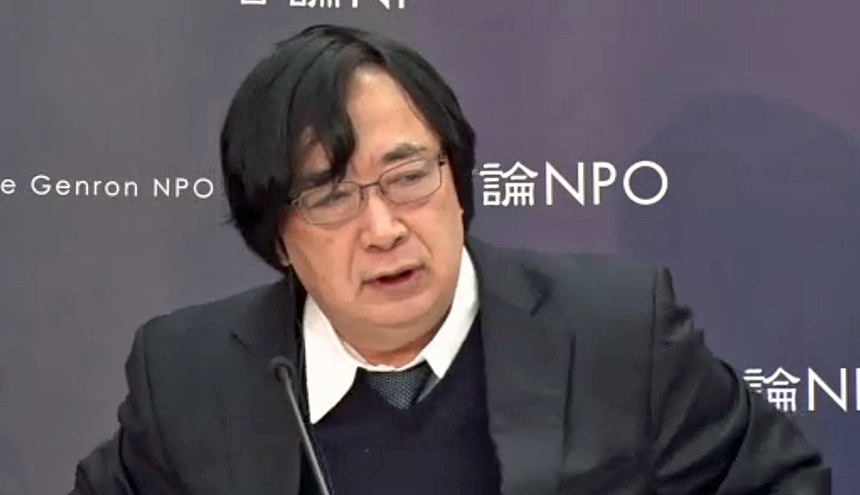
In response, four presenters were asked to provide the foundation for the following discussion: from the US, Gary Roughead, retired US Navy Admiral and former Commander of both the Atlantic and Pacific fleets; from China, Zhang Tuosheng, who has served for many years as Chairman of the Academic Committee at the China Foundation for International and Strategic Studies, a PLA-affiliated think tank; from Japan, Shinsuke Sugiyama, former Ambassador to the US; and from South Korea, Choi Kang, Vice President of the Asan Institute for Policy Studies.
Although these Asia Peace Conference sessions were closed to the public, it was decided that the statements made by the first four speakers would be released publicly, while the subsequent discussions would be held under the Chatham House Rule, which states that information can be used freely, but "neither the identity nor the affiliation of the speaker(s), nor that of any other participant, may be revealed."
The participants from China, the US, Japan, and South Korea engaged in a spirited debate-each side looking to the other for the underlying reasons behind the increased risk of conflict in the Taiwan Strait, each side looking to the other to implement measures to avoid such a conflict. Subsequently, over the course of the conference, it became increasingly obvious that there are major differences in how the different countries concerned view the current situation.
The Chinese delegation stated that their intentions for a peaceful reunification with Taiwan remain unchanged, and suggested that in order to avoid conflict, the US should refrain from supporting Taiwan's stance towards independence and that Taiwan should be persuaded likewise. However, the security experts from the US and Japan stated that conditions have changed in that China's stated desire for a peaceful unification with Taiwan is losing credibility in light of its actions in Hong Kong and the military exercises it has been conducting. They believe that China should clarify its stance regarding avoidance of armed action.
A participant from Japan added that the fundamental position of Japan regarding the One-China policy remains clear and unchanged; Japan does not support the independence of Taiwan.
Some said that the deepening conflict between the US and China, combined with China's actions in the region, are contributing to tensions over Taiwan. However, the participants in the conference shared the opinion that what has been lost in the region is mutual trust, and that is an additional reason that strategic dialogue is needed between the US and China.
It has also become clear that the various previous agreements made regarding crisis management methods to prevent conflict between the US and China are not functioning as designed. Prompt dialogue over the priority issue of the Taiwan Strait is necessary, and all haste must be made to construct a mechanism for crisis management. There was general consensus about these points among the participants.
Participants
【The United States】
Gary Roughead (Admiral, U.S. Navy (Retired))
Mark Montgomery (Executive Director of the Cyberspace Solarium Commission)
Frank Jannuzi (President and CEO, The Maureen and Mike Mansfield Foundation)
Robert P. Girrier (President Emeritus, Pacific Forum International and Senior Fellow, Center for Naval Analyses)
【China】
Jia Qingguo (Professor and former Dean of the School of International Studies of Peking University)
Yang Chaoying (Vice Chairman, China Foundation for International & Strategic Studies (CFISS)
Zhang Tuosheng (Principal Researcher, Chairman of Academic Committee, Grandview Institution)
Teng Jianqun (Senior research fellow at the Department for American Studies, CIIS)
Zhou Bo (Senior fellow of Center for International Security and Strategy Tsinghua University)
【Republic of Korea】
Choi Kang (Vice President at the Asan Institute for Policy Studies)
Heo Taekeun (Former Brigadier General of Ministry of National Defense)
【Japan】
Yoji Koda(former Commander in Chief, the Self Defense Fleet)
Shinsuke Sugiyama(former Vice-Minister for Foreign Affairs, Ministry of Foreign Affairs)
Yoshihide Soeya(Professor Emeritus of Political Science and International Relations at the Faculty of Law, Keio University)
Yuji Miyamoto (Chairman of Miyamoto Institute of Asian Research; Former Ambassador to the People's Republic of China)
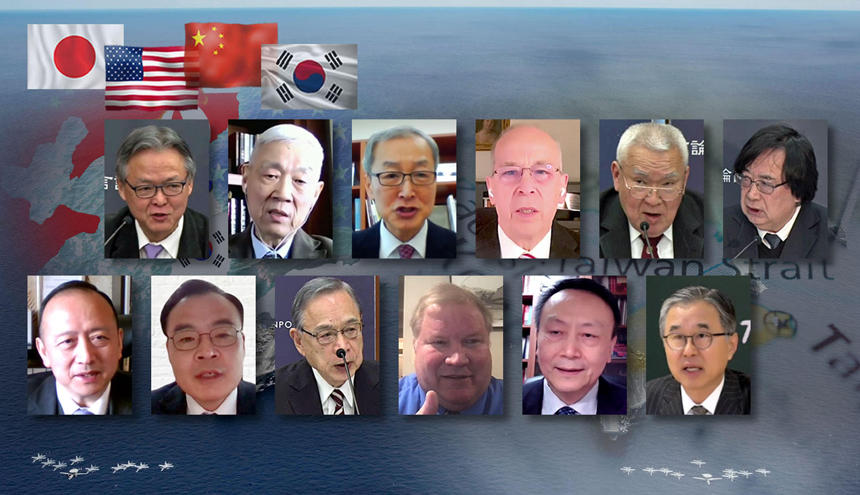
Before beginning the discussion for this session, four presenters were tasked with providing their insight on avoiding conflict over Taiwan.
Uncovering broader common interests through strategic dialogue
Retired US Navy Admiral Gary Roughead offered the opening remarks for the discussions.
"I've been involved in matters in the Pacific for quite some time, and still remain so. I thought it's important to put discussion of Taiwan in context of what I call the arc of the military-to-military relationships. It began with my first introduction to the PLA in the early 90s, and I would say that at that time the military-to-military relationship was a time of uncertainty. And I would submit that, again, we are in a time of uncertainty."
Roughead explained how there then arrived a "period of optimism," during which there was more interaction between the militaries of the US and China, development of personal relationships which allowed for more effective communication, and engagement in various cooperative activities. Roughead described how the relationship then turned to one of disappointment, which he believes largely arose from a "lack of reciprocity." Now the relationship has again returned to one of uncertainty, he said, and explained that people are no longer asking, "where will the relationship go?" Roughead suggested that instead people are now asking the more pessimistic question, "How will it end?"
"The task before us," Roughead continued. "Was to discuss the possibility of conflict in the Straits of Taiwan and the efforts to prevent it. There is no question in my mind that conflict in the Straits is possible."
Roughead emphasized that what they should be discussing is how probable such a conflict is and what the consequences of a conflict would be, adding that the measures currently in place are limited.
"The increased activity (in the region), and the nature of that activity, renders those rudimentary protocols like CUES (Code for Unplanned Encounters at Sea) inadequate for the type and the degree of risk that we face around Taiwan. Those rudimentary protocols lack the speed that is required, and the habitual and the practiced channels of communication that get better with time. In my view, we are at a time where accidents and incidents can escalate very, very quickly," Roughead explained.
In order to avoid such a situation, he believes that the priority must be for the two countries to "engage in a constructive strategic dialogue." On the strategic level, the dialogue should focus on the "broader common interests" through which the countries "might be able to make progress."
To conclude, Roughead touched on the perceived global decline of US influence due to government decision-making, extensive public debate, and social issues currently facing the country before calling for a renewed effort for more cooperation.
"I always keep in mind the great American author who is (often quoted) as saying, 'The reports of my death have been greatly exaggerated.' I think now is the time when we have to commit ourselves to some renewed strategic and operational dialogues, to reduce the possibility, the probability, and the consequences of conflict, particularly in the vicinity of Taiwan. And look for every opportunity to restart and to reengage and to return to that time of cooperation and optimism."
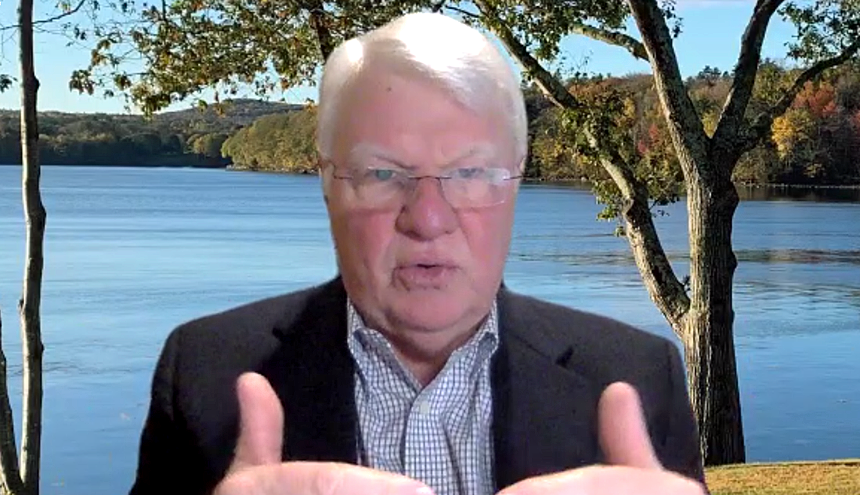
Three areas of risk for military conflict in the Taiwan Strait
Zhang Tuosheng of the China Foundation for International and Strategic Studies was next to take the podium, and he began with a comment on the possibility of a conflict over Taiwan with some background from the Chinese perspective.
"I think since Tsai Ing-wen of the DPP (Taiwan's Democratic Progressive Party) came to power in 2016, she has refused to recognize the 1992 consensus...resulting in the suspension of institutional dialogue between the two sides of the Taiwan Strait, severe degradation of cross-strait relations, and disrupting the peaceful development trend of the previous eight years. The US is exaggerating that China will attack Taiwan by force, and some American officials and experts are calling for the US government change its cross-strait strategy from 'strategic ambiguity' to 'strategic clarity' in order to fully defend Taiwan. The situation across the Taiwan Strait is becoming more tense," Zhang explained. He summarized his concerns by describing three main risks of military conflict in the Taiwan Strait.
"First, as both China and the US continue to strengthen their military presence in the Taiwan Strait and as Taiwan carries out various military activities, accidents or misjudgments may cause contingencies between military planes and warships. Second, the US continues to pressure China...in the Taiwan Strait, and even touches China's 'bottom line' from time to time. Once these extremely dangerous acts cross the bottom line set in the anti-secession law, China will negatively resort to non-peaceful means to counter pro-independence and secession attempts. Military conflict will be inevitable. Third, the United States has been exaggerating that China will attack Taiwan by force, calling for all-out efforts to strengthen Taiwan's defensive capability and the support capability of the US in order to prevent the so-called Chinese invasion. Once these propositions are put into practice, it will certainly lead to military conflicts, even serious ones," Zhang stated.
Zhang then reminded participants that the entire Taiwan question is a "leftover from the Chinese civil war" and stressed that it "is a Chinese internal affair" in which no other country should interfere. He stated that all efforts to avoid conflict should be based upon that understanding, before adding some suggestions on how to ensure peace.
"Adherence to the One-China principle should be the primary condition. Second, the relevant countries must never send the wrong signals to the Taiwanese independence forces," he said.
In addition, he stated that the Chinese government should "unswervingly pursue the policy of peaceful reunification," but emphasized that military force will continue to function as a deterrent to Taiwanese calls for independence.
"It is also important for the two sides of the Taiwan Strait to resume dialogue and improve relations in order to prevent military conflict between them. But this must be based on the 1992 consensus, which, at its core, means that both the mainland and Taiwan belong to one and the same China," Zhang concluded.
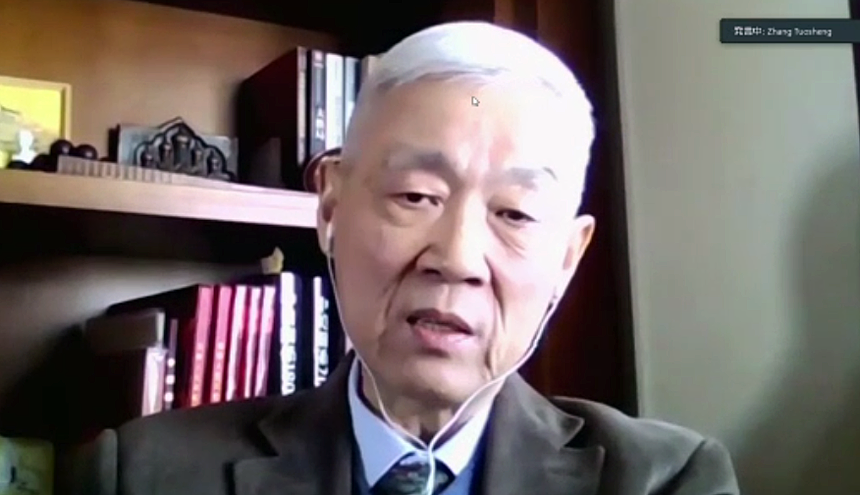
Steadfast dialogue important for peaceful problem resolution
Former Japanese Ambassador to the US Shinsuke Sugiyama opened his remarks by addressing Zhang Tuosheng to assure him that Sugiyama believes all in attendance at the conference fundamentally agree that the Taiwan issue is a domestic issue for China. He added that this stance is shared by the Japanese government.
"The Japanese Diet has asserted that (Taiwan) is fundamentally a Chinese domestic issue," Sugiyama said. Moreover, he noted that the joint US-Japan statement issued by Prime Minister Suga and President Biden issued after their April 16 2021 meeting touched upon Taiwan for the first time in 50 years since the Sato-Nixon statement made in 1969.
"When I heard that news, I got a strong sense that something was wrong," he stated, pointing out that the wording in the two joint statements was different.
"The wording in the 1969 joint statement was, '...the maintenance of peace and security in the Taiwan area was also a most important factor for the security of Japan.' The statement from last year contained the phrase, 'We underscore the importance of peace and stability across the Taiwan Strait,' with an additional clause stating, '...and encourage the peaceful resolution of cross-Strait issues.' This phrasing is one that the Japanese government has been using for many years. Almost the same phrasing was used during the US-South Korea summit that took place a month later," Sugiyama explained.
He reiterated that all the actors involved do understand the Chinese position, and pointed to the Japanese government point to show that China will find no such statement asserting that 'there are two Chinas' or supporting the independence of Taiwan. That is further illustrated by the summit statement, namely, 'We underscore the importance of peace and stability across the Taiwan Strait.'
Sugiyama explained that the official Japanese position includes no intention of increasing military tensions, but added that there is a key difference between the Taiwan Strait and Taiwan.
"The Taiwan Strait is not entirely within the territorial water borders of China, so it is not untoward to consider the importance of peace and stability in the Strait a matter of international interest. On top of that is the US-Japan statement clarifying their position of wanting to promote a peaceful resolution of cross-strait relations. What is different now compared to the situation in Northeast Asia in 1969 is that now I can't deny that the threat is real," he said.
As a diplomat, he emphasized that both diplomatic dialogue and strategic dialogue are essential in this situation, and that, "It is important to put our efforts into resolving problems in a peaceful way through steadfast dialogue."
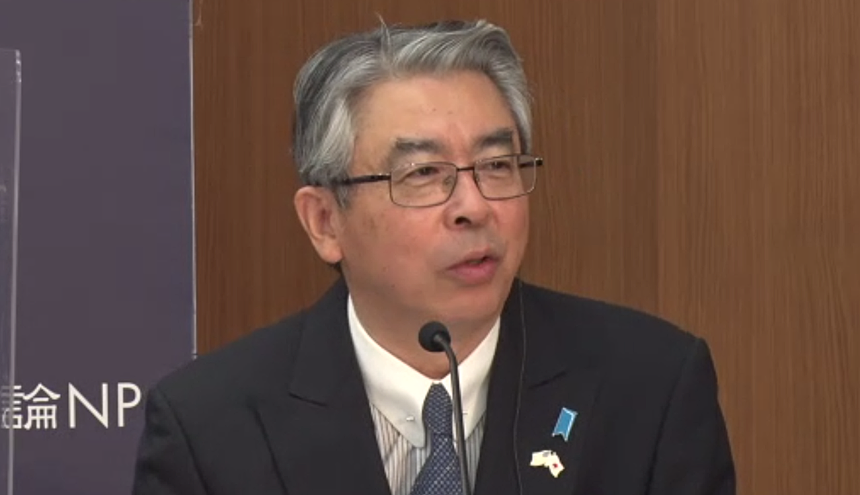
A crisis prevention mechanism urgently needed in Northeast Asia
The last to offer an opinion on the issue was Choi Kang, Vice-President of the Asan Institute for Policy Studies in South Korea.
"The concern I have personally is in the change in the response of China in the past several years . Almost everyone expected that Tsai Ing-wen was going to lose the election, but after seeing what happened in Hong Kong, Tsai Ing-wen became very popular and won the election. Everybody agrees on the One-China policy. In addition to the One-China policy, both sides underscore the peaceful resolution ? the peaceful reunification of Taiwan, one day. But Chinese behavior over the past couple of years has not impressed (upon most people) that China is seeking a peaceful resolution over the Taiwan Strait issue," he said.
Choi expressed his agreement with former Admiral Gary Roughead.
"The frequency and magnitude of Chinese military activities around the Taiwan Strait have increased very sharply. That raises concerns ? especially during the Xi Jinping era. I agree with (Admiral Roughead) arguing for strategic and operational dialogues, but those two dialogues are meaningful only when the two big powers agree to restore the status quo in the region."
Choi then noted that he is unsure whether China is aiming to maintain the status quo or taking a more "revisionist approach" toward the international order.
"I think there must be a basic understanding between the two big powers about the future of the international order. That is the basic line where we can start the strategic dialogue and operational dialogue ? the military-to-military dialogue."
He added that reports show that there seem to be three possible scenarios for the future.
"One is the continuation of the show of force by China over Taiwan. That could alarm almost everybody and actually heighten the tension. Second is the...public message that could enflame anti-Chinese feeling not only in Taiwan, but also other parts of the world. Third, maybe the lowest possibility, is occupying some territory in Taiwan, claiming it as a "recovery," maybe as Russia did in the former Soviet territory of the Donbas area. I think the probability of a physical conflict between Taiwan and China is very low, but there is a possibility of accidents or incidents over military maneuvers taken by either side, so we must be careful in managing such things."
Choi also called for the creation of a regional crisis prevention mechanism.
"We need to have region-wide principles. A code of conduct must be agreed upon by the countries in the region to safe-guard regional peace and stability against accidental war."
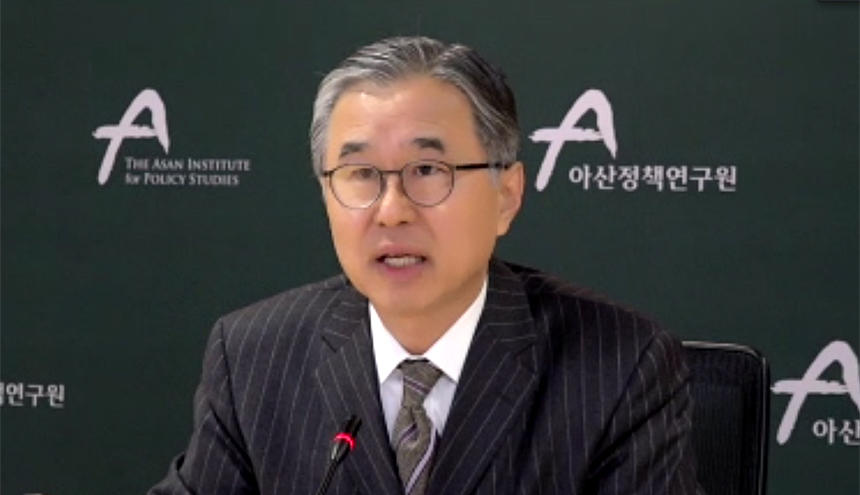
Loss of mutual trust is behind the US-China conflict over the Taiwan Strait
Following the four presentations, a closed discussion was held between 18 participants from the four countries. The discussion revealed major discrepancies in how the participants from the different countries view a potential contingency over Taiwan.
The Chinese position on the Taiwan issue is that it is a domestic one, rooted in Chinese sovereignty, and therefore a core issue of national interest. The reason China's behavior has changed is because they believe the situation has changed; since the DPP took power, the administration of Tsai Ing-wen has retreated from the agreement on the One-China principle, and from the Chinese perspective, the US is supporting Taiwan in that retreat.
For that reason, the agreement among the Chinese speakers was that in order to calm the tensions over a potential conflict, the US should work to convince the Taiwanese authorities to return to the spirit of the 1992 consensus (agreeing in principle to the One-China policy), and should refrain from offering Taiwan its support.
In response, participants from Japan, the US, and South Korea stated that regardless of the current situation in Taiwan, the position of Japan, the US and South Korea has not changed at all. Their policies are fundamental based in the principle of "One China."
However, China's recent behavior has raised concerns in those three countries that China is possibly looking to reunify the country through force rather than peaceful means; and that these issues seem to be arising from a lack of trust ? a reluctance to compromise to the very last.
A participant from the US stated the belief that Tsai Ing-wen won the election in Taiwan due to the crackdown on citizens in Hong Kong. With the situation now having changed, people in the US no longer trust what China says, so China should promise not to use force.
China sees a clear difference between Ukraine and Taiwan
During discussion on the possibility of China achieving reunification through military action against Taiwan, parallels were drawn between the situation in the Taiwan Strait and Russia's military invasion of Ukraine.
However, the Chinese position on this is that there are two clear differences in the circumstances surrounding the two countries. First, while the invasion of Ukraine is a consequence of Russia's attempts at expanding its sphere of influence, the issue over Taiwan is a domestic issue and the fact that Taiwan is a part of China has been recognized by the world.
Second, there seems to be a clear difference in the US response to the situation in either country; the US is not directly intervening in the situation in Ukraine, but it seems to be doing so with Taiwan. The underlying reason for the difference in the US responses, it was suggested, may lie in the fact that the US and Russia share a "strategic stability"that was established during the Cold War, but China and the US have no suchmechanism in place.
US-China dialogue essential to peace and stability in the Taiwan Strait
One comment made during the discussion suggested that the ambiguous behavior on the part of both the US and China is behind the heightened tensions in the Taiwan Strait, and that is amplifying regional instability in this region.
China suspects that the US military stance is aimed at supporting Taiwanese independence, and the US is making no effort to allay China's suspicions. In addition, while China's actions do serve as a deterrent to Taiwan's achieving independence in the short term, they offer no explanation for China's long-term military expansion throughout the region.
Moreover, it was pointed out numerous times during the discussion that no progress has been made in achieving mutual understanding between the countries involved in Northeast Asia, and that is what makes statements made by each country lose credibility in the view of those on the other side of the table. That is why it was dialogue was mentioned so many times as being vital is to crisis management in the region.
The participants from all four countries are well aware of the dangers of conflict in the area around Taiwan, and the discussion turned to what kinds of efforts are necessary to prevent a conflict in the Taiwan Strait and ensure peace and stability.
All agreed that there is an urgent need for a strategic dialogue to prevent contingencies in the Taiwan Strait, and that there needs to be an agreement reached on reviving the non-functioning crisis management framework already in place between the US and China. It was also suggested that such a framework should be extended to span all of Northeast Asia.
Bringing the first closed session to an end, participants agreed on the necessity of honest dialogue aimed at filling the existing gaps in communication through increased efforts to foster mutual trust.
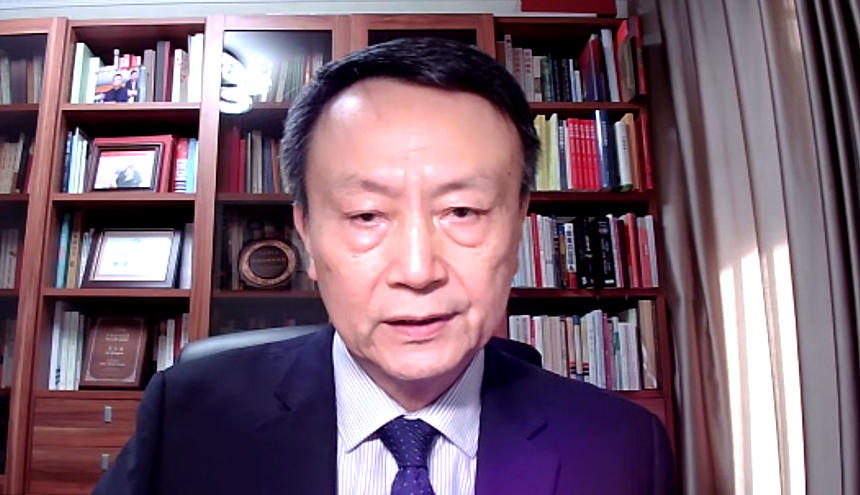
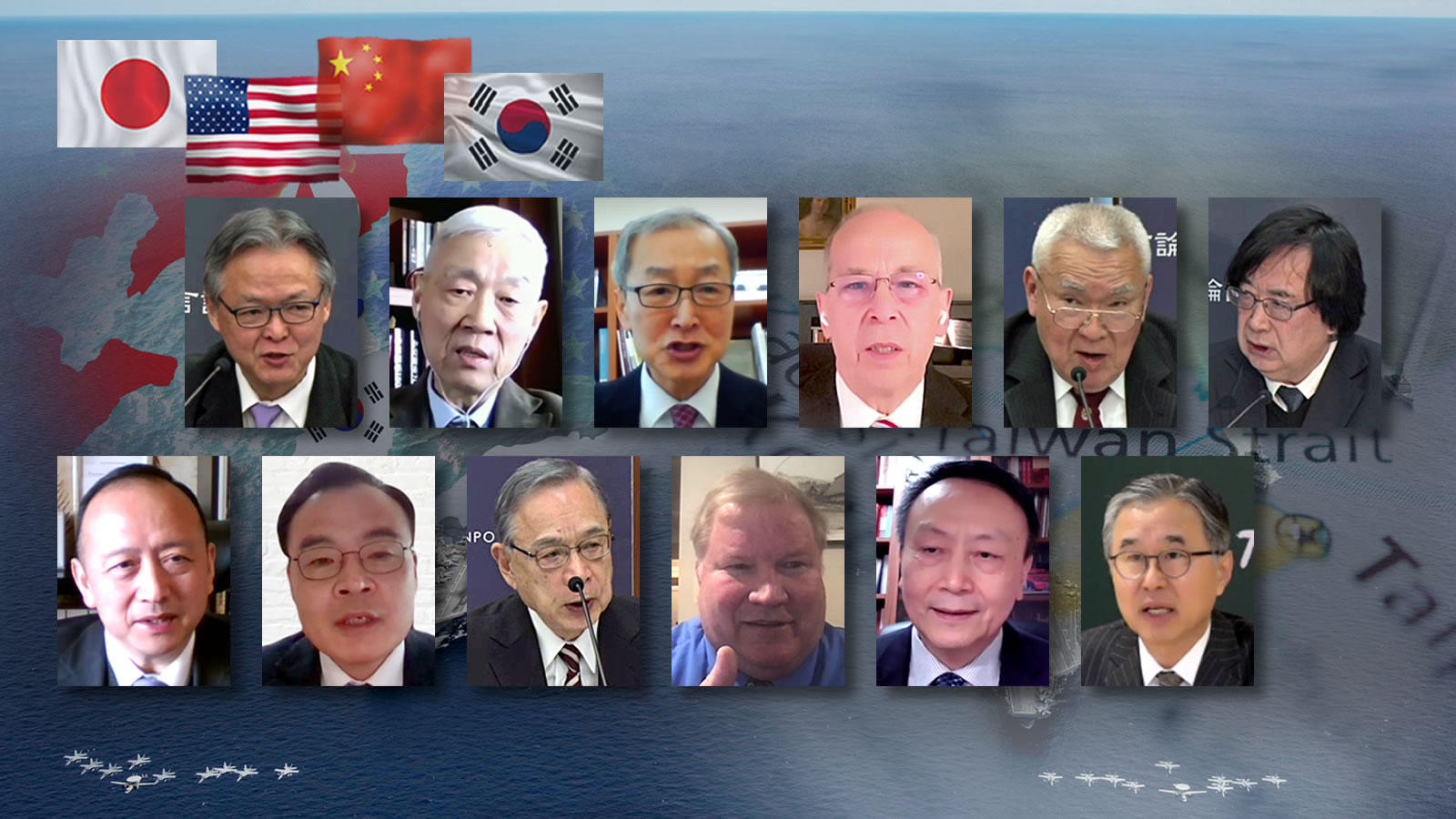
Post a comment